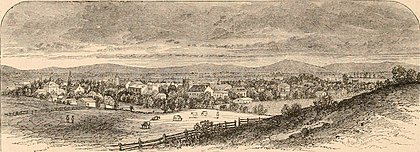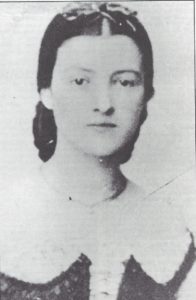
Courtship in the Midst of War
What were courtship and the decision to marry like for a young Southern woman in the midst of the Civil War? Take a peek inside a diary and see:
Eighteen-year-old Kate Sperry of Winchester, VA, enjoyed a stream of gentleman callers in the early months of the war before the troops marched off for Manassas in July 1861. Among her beau at the time was Dr. E. Newton Hunt, a widowed doctor from Mississippi who was several years older than Kate, of whom she wrote, “I’ve half a notion to tumble in love with him” (44). However, the contest for Kate’s hand had only just begun.
However, Kate was far from deciding whom she really loved and even farther from deciding whom she would marry. She kept a list, and by the middle of the war, she had added almost a dozen names to it.
In June 1862, Kate met John Strurman, another major contender for her heart. By her own admission, he was her first love. During John’s time in Winchester, the two became inseparable until his regiment pulled out at the end of July. He left her his prize handkerchief and insisted, “Don’t go letting any other fellow run after you,” and Kate wrote that she had “never missed anyone in [her] life as [she] did him” (54). Throughout August and September, she pined away for him. But he was “reckless” (55), and recklessness, although exciting, was not a recommended quality for a husband.
Meanwhile, Dr. Hunt had been conducting a letter-writing campaign to win Kate’s affections. In August of 1861, Kate received her first letter from him. He wrote of “falling victim” to her “innumerable charms” and of his love for “the flower of the Valley of Virginia” (45). He sent several other letters, but she was skeptical of his intentions. She confided in her diary: “He’s another flirt—if he comes here, I’m going to lead him a life for being such a fool–. I’m sick and tired of men that I care nothing about—wish someone would come whom I do think something of” (56).
However, when Dr. Hunt and several other beaus called on her, in late 1862, when their way through Winchester, Kate’s opinion of him improved, and she wrote that she liked Hunt better than any of the new gentlemen. She goes on to say, “He was dressed to kill and had a servant hold his horse—put on more airs” (56). His maturity, strength, and power commanded her admiration. This was the last time that she would see him for two years, two years in which he eventually surpassed all of the other contenders for Kate’s hand.
But Hunt had not won Kate’s loyalty yet, and she continued in light-hearted courtships with eligible officers stationed in Winchester. Meanwhile, as the months pass, she wondered if she would ever find the man for her. On April 30, 1863, she wrote, “Today’s my birthday—20 years old—already begin to feel antiquated—if I keep on I’ll be an old maid.” Kate cared about the Confederate cause. She smuggled messages and letters across enemy lines. She worked to care for the sick. She would not think of even looking at any of the Yankees as potential beau. However, her primary concern became more and more about her future and who and if she would marry.
Within a week of her lonely birthday entry, she received a letter from Hunt that astonished her. He wrote, “From the first time of our meeting… there has flowed a pure stream of thought and affection for you that I have never dared to whisper, breathe or insinuate…” For the first time, she started to take his attentions seriously.
However, Hunt was far away, and Kate wished that she could see him “face to face.” It had been almost a year since she had seen him. All and all, they had spent little time together, but the persuasive power of his letters was strong. On Sept. 19, 1863, she wrote, “It’s strange, but I don’t know him—have met him so seldom and then never enjoyed a tete-a-tete with him, and now to think – whew. I do like him, and however, most amazingly, and will keep on liking him ‘til he secedes—I’ve not much faith in man. Although he has written again and again to me that he loved me and tried to convince, I have never until his last letter been convinced. I have written him that I’m all “OK” and he construes it rightly—so I presume it’s all understood between us” (65). At this point, Kate had informally accepted Hunt.
The daring young men on horseback couldn’t compete with a steady, intelligent man who knew how to communicate the depth of his feelings with the written word. On February 27th, she received Hunt’s formal proposal. In his letter, he told her about his family, his finances, and future plans. He even provided character references. Kate confided in her diary: “I’m most afraid to say yes and don’t want to say no—either must be said, and he certainly thinks I love him—I do think of him more than anyone else, but ask myself the question, “Wilt it last?” oh dear, what a bother. I’ve got the blues most miserably from it” (67). But despite her uncertainty, she wrote him the next day accepting his offer.
When John Sturman, her first love, finally made it back to the Shenandoah Valley in June 1864, Kate decided not to see him. She had made her choice, and she had come to realize “It would have been impossible for me to have married him. John is too wild, too dissipated for me—my first love, whew. Second or third love is the best because it is not so crazy and blind” (69).
However, in the topsy-turvy world of the war, Kate was not as certain as she proclaimed. She still had not seen Hunt since October 1862. In late August 1864, another contender expressed his interest. Capt. Haslett, who was about “30 years old—very tall and handsome,” decided that he was in love with Kate and pursued her relentlessly until she traveled to North Carolina to be wed (70-71). Kate was torn between her prior commitment to Hunt and her attraction to Haslett.
Unfortunately for Haslett, his chances for success were dampened by an event outside of his control. Kate’s grandfather passed away, and the family home, where Kate had been living, had to be sold for debts. Kate would no longer have a home in Winchester. In response to the uncertainty of her living situation and with even her bedroom furniture being sold, Kate decided to travel to Goldsboro, NC with her aunt where Hunt was permanently stationed. Traveling there would provide Kate a place to stay and an opportunity to see her finance.
However, Haslett could not bear the thought of losing her and even proposed marriage. Kate wrote that he was “almost irresistible” and that she liked him “next to Dr. Hunt” and wished that she “was married and done with it. It’s all so tiresome and my heart is almost broken.” But Kate traveled on, and on October 8th, 1864 when she saw Hunt at last for the first time in two years, her doubts dissipated. This was the man she wanted to marry.
A month after the wedding, Kate wrote, “I love him so much—sometimes I’m afraid it’s wicked of me to idolize him as I do—but cannot help it—all the love in my nature is his” (73).
Amongst the uncertainty of war, Hunt’s pen and steadfastness won the maiden.
Sources: Stuart Bell Jr. Archives, Handley Library, Winchester-Frederick County Historical Society



10 thoughts on “Courtship in the Midst of War”
This is such an attractive website and a fascinating love story.
Thank you!!!
GREAT! TRUE LOVE CONQUERORS AII!
Thank you! I didn’t even that in the story. I missed it:)
Ahh, sweet love!!! I was afraid somewhere in the story one of her suitors might have gotten shot or worse. Wonderful to see love win!!! Thanks for this story, Sherry!! 🙂
Now that you mention it, it’s amazing that her suitors seemed to have survived the war. But yes, I love stories where true love triumphs! I was excited that once she made it to North Carolina and saw him again for the first time in two years that she knew she’d made the right choice:)
This is a great story, Sherry.:)
Thank you, Kathy!
All’s fair in love and war, as they say. And this was true love!
Yes, it was a battle for her heart. And the good doctor played his cards and his words right:)
Comments are closed.